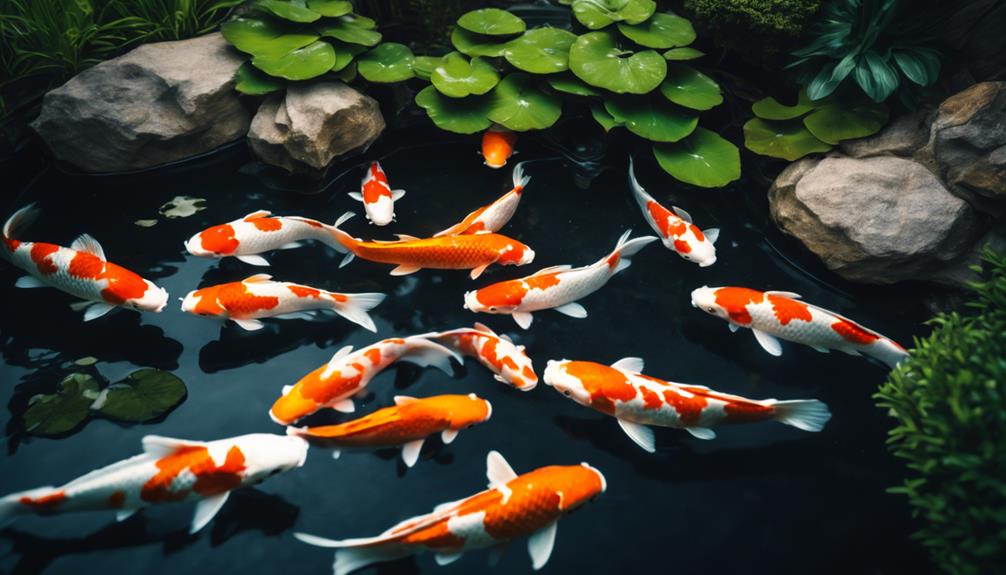You optimize your koi pond filtration system by regularly monitoring and adjusting water quality, selecting the right filtration system, and maintaining pump system efficiency. Perform regular water testing to identify imbalances and make adjustments to maintain prime water quality. Certify a well-designed filtration system, including mechanical, biological, and chemical filters, is in place to remove waste products and toxins. By maintaining perfect water conditions, you'll create a stress-free environment that fosters healthy koi growth and successful breeding. Now, explore the nuances of breeding koi and uncover the secrets to raising vibrant, healthy offspring.
Table of Contents
Key Takeaways
- Maintain a well-designed filtration system with mechanical, biological, and chemical filters to remove waste and toxins.
- Regularly test water parameters, including pH, ammonia, nitrite, and nitrate levels, to ensure prime water quality.
- Perform partial water changes of 10% weekly and clean filter media monthly to maintain optimal filtration performance.
- Ensure pump system efficiency to provide ideal water conditions, including oxygen levels, water temperature, and circulation.
- Monitor and adjust water temperature, pH, and other parameters to guarantee a stress-free environment for breeding koi.
Preparing the Breeding Environment
Regularly monitoring and adjusting the water quality in your koi pond is imperative for creating a perfect breeding environment. When breeding koi fish, maintaining prime water quality is necessary to safeguard the health and well-being of your fish.
You'll need to select the right filtration system and maintain it properly to achieve this.
Start by testing your water regularly to identify any imbalances or issues. You should check pH levels, ammonia, nitrite, and nitrate levels, as well as dissolved oxygen levels. Make adjustments as needed to maintain prime water quality. This may involve adding beneficial bacteria, adjusting water flow, or performing partial water changes.
It's also pivotal to provide a stress-free environment for your fish. Avoid overcrowding, provide adequate hiding places, and maintain a consistent water temperature.
Understanding Koi Mating and Breeding
As you set up your breeding environment, it is crucial to understand koi courtship behavior, which involves the male and female swimming together in a circular motion before spawning.
You'll need to prepare a breeding tank that mimics these natural conditions, complete with a reliable filtering and pump system to maintain superior water quality.
Koi Courtship Behavior
When observing your koi pond, you may notice a sudden change in behavior among your fish, particularly in the late afternoon, as males begin to display aggressive behavior towards each other and females, signaling the onset of koi courtship behavior.
During this period, the female koi releases a pheromone that guides the male to the spawning location, often accompanied by a change in water temperature or quality. The male koi will then spit sperm, and the female will release her first batch of eggs, with the process repeating until the female is exhausted, and some eggs are naturally culled by the parents.
| Factor | Influence on Koi Courtship Behavior |
|---|---|
| Water Quality | Essential breeding conditions occur in well-oxygenated tanks with balanced water chemistry |
| Tank Size | Larger tanks provide more space for koi to exhibit courtship behavior |
| Presence of Other Koi | Presence of other koi can influence courtship behavior, ideal breeding occurs with a balanced ratio of males to females |
| Water Temperature | Changes in water temperature can trigger courtship behavior |
| Breeding Pond Conditions | A well-maintained breeding pond with ideal water conditions increases chances of successful koi breeding |
As a koi fish breeder, understanding and recognizing koi courtship behavior is vital for successful breeding. By recognizing these signs, you can identify ideal breeding times and provide the necessary conditions for successful spawning, ultimately leading to successful koi breeding.
Breeding Tank Preparation
You'll need to set up a dedicated breeding tank with specific conditions to facilitate successful koi mating and breeding. This tank should be separate from your main pond to prevent stress and competition from other fish.
For breeding tank preparation, select the right size tank based on the number of breeding stock you'll be working with. A general rule of thumb is 10-20 gallons per pair of koi.
Your breeding tank should also have a reliable filtration system to maintain peak water quality. A high-quality filter will help remove waste and excess nutrients that can hinder successful breeding.
You'll want to cycle the tank before introducing your breeding stock to guarantee a healthy environment. Monitor water parameters closely, making adjustments as needed to maintain a stable pH, ammonia, and nitrite levels.
Selecting the Right Breeding Stock
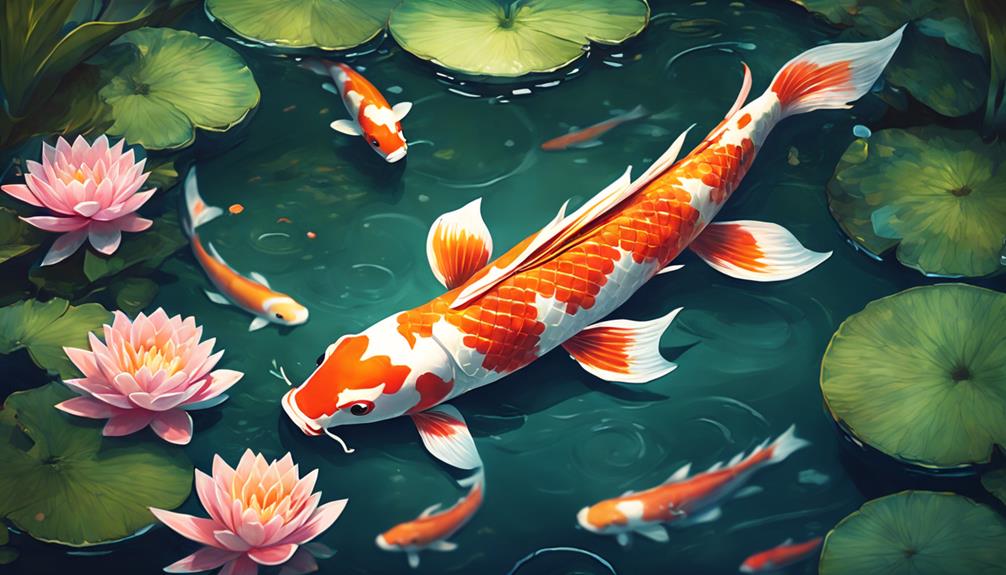
To increase the chances of producing high-quality offspring, select healthy, mature koi with desirable characteristics such as vibrant colors, patterns, and body shape as your breeding stock. This is vital in koi fish breeding, as the quality of your breeding stock directly affects the quality of your offspring. When choosing koi, select those that exhibit desirable traits, such as a strong immune system, good body shape, and vibrant colors.
| Characteristic | Desirable Traits | Reason |
|---|---|---|
| Color | Vibrant, intense colors | Affects offspring's coloration |
| Pattern | Well-defined, symmetrical patterns | Influences offspring's pattern quality |
| Body Shape | Strong, well-proportioned body | Affects offspring's growth rate and overall health |
| Age | Mature koi (2-5 years old) | Guarantees koi are physically and sexually mature |
| Health | Free from diseases and deformities | Reduces risk of passing on genetic defects |
Remember to choose koi of the same species to increase the chances of producing high-quality offspring with desirable traits. A high-protein diet should also be fed to your breeding stock for several weeks before breeding to improve fertility and increase the chances of successful spawning. By selecting the right breeding stock, you'll be well on your way to producing high-quality koi.
Providing Optimal Water Conditions
To provide ideal water conditions for your koi, you'll need to focus on three key areas: monitoring water quality, maintaining your filtration system, and ensuring pump system efficiency.
By paying attention to these critical factors, you'll be able to create a healthy environment that supports the well-being and breeding success of your koi.
In the following sections, we'll explore each of these points in detail, providing you with practical guidance and expert insights.
Water Quality Monitoring
Regular monitoring of your koi pond's water quality is essential to detect any deviations from ideal parameters, guaranteeing the health and well-being of your fish.
You should perform regular water testing to check for ammonia levels, pH levels, and nitrate levels. Ideally, your pH should range from 6.5 to 8.5, with ammonia and nitrite levels at zero, and nitrate levels below 20 ppm.
You'll also want to maintain ideal water temperature between 68-74°F (20-24°C) to prevent stress on your koi.
Additionally, guarantee adequate aeration, as dissolved oxygen levels should be at least 5 ppm.
To maintain ideal water quality, you'll need to perform weekly water changes of at least 10% and use a gravel vacuum to remove debris and waste from the pond floor.
Filter Maintenance Essentials
Your filter maintenance routine plays a vital role in providing ideal water conditions for your koi to thrive, as a well-maintained filtration system is essential for removing waste, excess nutrients, and toxins that can harm your fish.
Regular backwashing of filters is pivotal to remove accumulated debris and prevent clogging, which can lead to poor water quality and stress on koi fish.
You should also clean filter media, such as bio-balls or ceramic rings, every 2-3 months to maintain peak biological filtration and prevent the buildup of toxins.
Performing partial water changes (10-20% every week) helps maintain peak water parameters and prevents the buildup of toxins, which can negatively impact koi breeding.
Additionally, monitor and adjust filter flow rates to guarantee proper water circulation and oxygenation, essential for koi health and breeding success.
Pump System Efficiency
Efficiently circulating water through your koi pond's pump system is crucial for providing ideal water conditions, as it directly impacts oxygen levels, water temperature, and the overall health of your fish.
A well-designed pump system guarantees that your koi receive the necessary oxygen and nutrients, while also keeping the water clean and clear.
To maximize pump system efficiency, consider investing in a high-quality pump that can handle the volume of your pond. You should also verify that your pump is properly sized for your pond's volume and that it's installed correctly to prevent energy waste.
When breeding koi, having a separate tank for spawning and rearing is imperative.
This separate tank should have sufficient space for your fish to thrive and receive proper care.
A well-maintained pump system in this tank will help keep the water clean and oxygen-rich, promoting healthy growth and development.
Caring for Koi Eggs and Fry
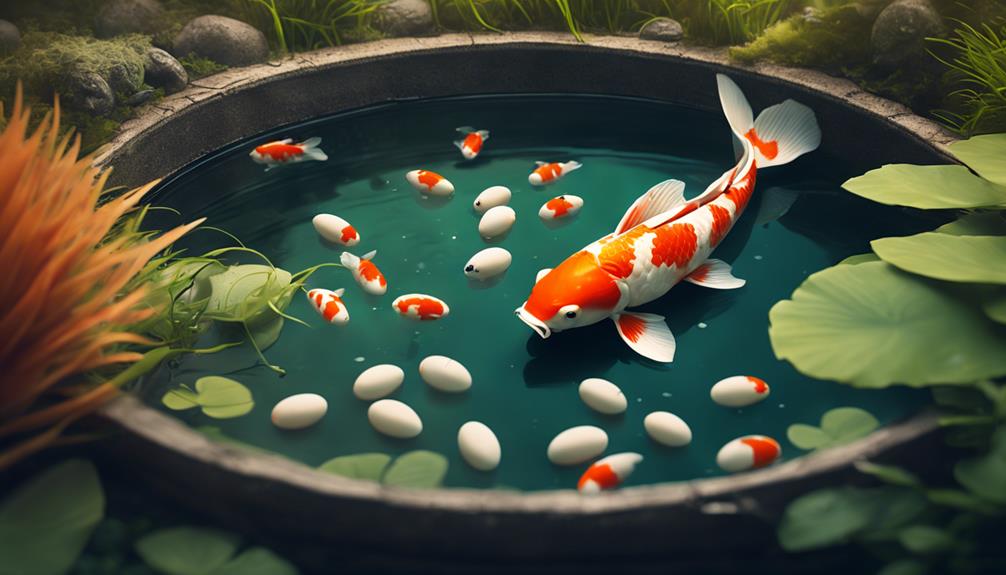
Caring for koi eggs and fry requires meticulous attention to water quality, as even slight fluctuations can prove disastrous for these delicate early life stages. During the breeding season, it's vital to maintain perfect water conditions to guarantee the successful development of fertilized eggs into healthy koi fry.
Monitor water temperature: Koi eggs typically hatch into fry within 3-4 days, and water temperature plays a critical role in this process. Aim to maintain a consistent temperature between 64°F and 75°F (18°C and 24°C) to promote healthy development.
Maintain ideal pH levels: Koi eggs and fry are sensitive to pH fluctuations, so maintaining pH levels between 6.5 and 8.5 is imperative. Regularly test your water pH to verify it remains within this range.
Provide adequate aeration: Increased oxygen levels during the breeding season can help prevent fungal infections and promote healthy growth. Verify your pond has sufficient aeration to support the developing koi eggs and fry.
Feeding and Nourishing Koi Fry
When feeding koi fry, it's vital to provide them with small, frequent meals throughout the day to cater to their rapid metabolism and support their growth and development. You should feed your fish small amounts of food several times a day, focusing on protein-rich foods to support their growth.
| Food Type | Nutrient-Rich | Ease of Digestion |
|---|---|---|
| Brine Shrimp | High in protein | Easily digestible |
| Commercial Baby Koi Meal | Rich in nutrients | Powdered for easy consumption |
| Chicken Egg Preparation | Essential for development | Used for the first few days |
Live foods like brine shrimp or infusoria are excellent options, as they're rich in nutrients and easily digestible. Commercial baby koi meal kits or finely powdered commercial koi food can also be used, but make sure to powder them to a size that's easily consumed by the fry. A well-known chicken egg preparation can be used for the first few days after birth, providing essential nutrients for the developing fry. Remember to avoid overfeeding, as it can lead to poor water quality and health issues in the fry. Remove any uneaten food regularly to maintain a clean and healthy environment.
Managing Breeding Risks and Challenges
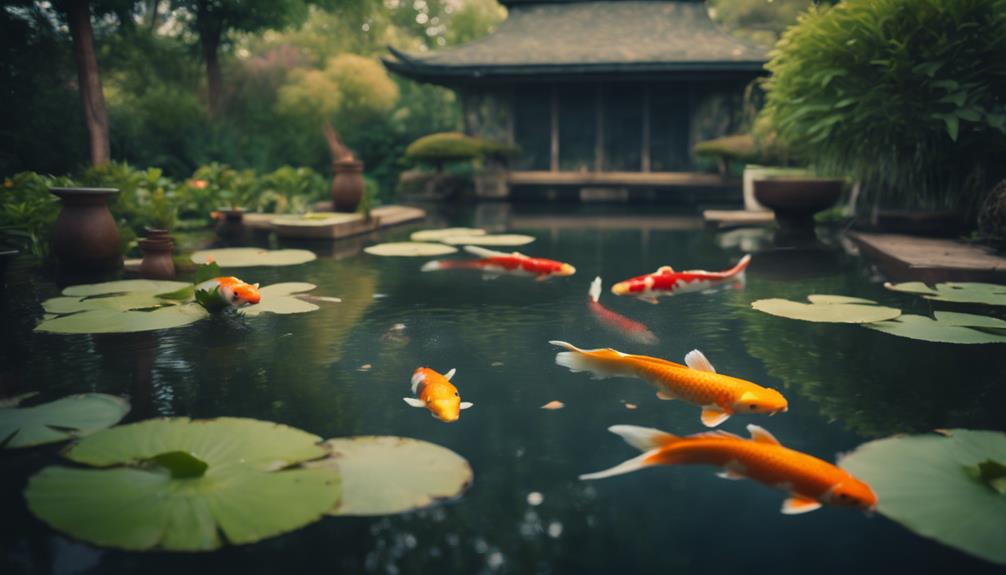
Your koi breeding endeavors can be fraught with risks and challenges that, if not addressed promptly, can jeopardize the health and survival of your prized fish.
As you set out on your breeding program, it's vital to be aware of potential issues that can arise and take proactive measures to prevent diseases and health issues.
Genetic diversity: Guarantee that your breeding stock is genetically diverse to minimize the risk of inherited health problems.
Environmental factors: Monitor water quality, temperature, and other environmental factors that can impact the health of your koi.
Disease management: Develop a protocol for identifying and treating diseases promptly, and have a plan in place for quarantining and isolating affected fish.
Maintaining a Healthy Breeding Pond
When it comes to maintaining a healthy breeding pond, you'll need to focus on three key areas: water quality control, filter system maintenance, and regular cleaning schedules.
By prioritizing these aspects, you'll be able to create an ideal environment for your koi fry to thrive.
Water Quality Control
To maintain a healthy breeding pond, you must prioritize water quality control, as it's the foundation of a thriving koi population.
A well-functioning filtration system is essential for superior water quality, and it should be able to process 10-15 times the volume of the pond daily. Additionally, regular water changes of at least 10% per week are necessary to remove built-up toxins and maintain a balanced ecosystem.
Three key aspects to focus on for superior water quality control are:
- Balanced filtration: Verify your filtration system includes mechanical, biological, and chemical filters to effectively remove waste, ammonia, and other pollutants from the water.
- Regular water testing: Use water testing kits at least weekly to monitor ammonia, nitrite, and nitrate levels, as well as pH and alkalinity, to identify and address any potential issues before they affect the health of the koi.
- Aeration devices: Install aeration devices, such as air pumps or water features, to maintain adequate oxygen levels in the pond, especially during the breeding season when oxygen demand increases.
Filter System Maintenance
Regular filter system maintenance is vital to guaranteeing the health and well-being of your koi, as a neglected filter can quickly lead to water quality issues and even disease outbreaks. To avoid this, you need to regularly inspect and clean the filter media to prevent clogging and achieve prime water flow. This is essential for maintaining a healthy breeding pond.
| Task | Frequency |
|---|---|
| Inspect and clean filter media | Weekly |
| Perform partial water changes (10-20%) | Weekly |
| Monitor and maintain prime water parameters | Daily |
Regular Cleaning Schedules
By establishing a consistent cleaning schedule, you can guarantee your breeding pond remains a healthy environment for your koi, and it starts with daily, weekly, and monthly tasks that target specific areas of the pond and its equipment.
To maintain top-notch water quality, your koi requires regular cleaning schedules.
Daily skimming removes debris and excess food from the pond's surface to prevent water quality issues.
Weekly water changes replace 10-15% of the pond water to maintain prime conditions for your koi.
Filtration system cleaning is necessary every 2-3 weeks to prevent clogging and certify efficient water circulation.
Breeding for Specific Koi Varieties
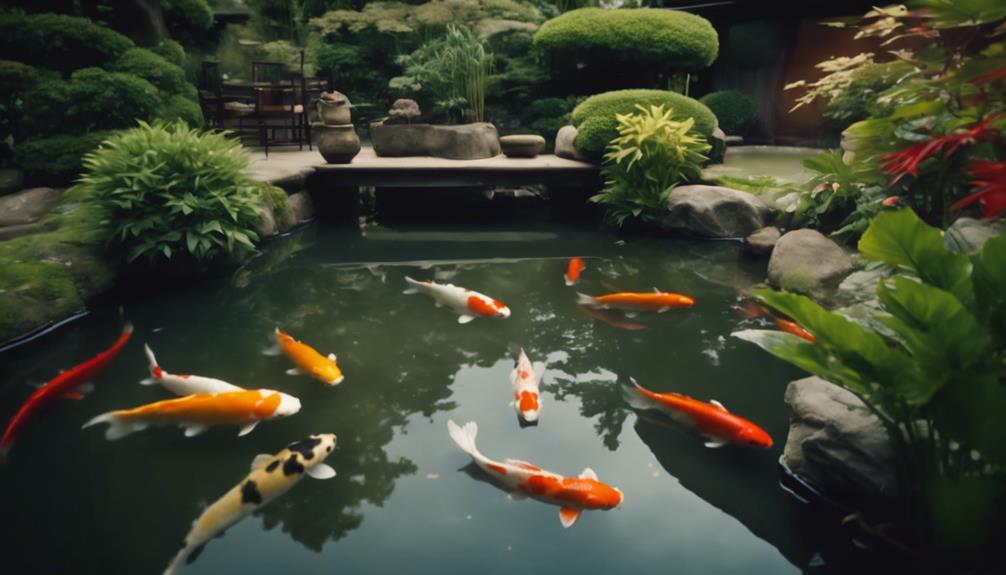
When developing a breeding program focused on specific koi varieties, you must carefully select parent fish that exhibit the desired traits and characteristics, as this substantially influences the quality of the offspring. This is especially vital for popular koi varieties like Kohaku and Sanke, which require precise breeding to achieve their distinctive colors and patterns.
| Koi Variety | Desired Traits | Breeding Considerations |
|---|---|---|
| Kohaku | White and red markings | Water temperature and quality during spawning |
| Sanke | Black, white, and red colors | Genetic makeup of parent fish |
| Showa | Black, white, and red colors | Linebreeding to concentrate desirable traits |
| Bekko | Solid black, white, or yellow | Attention to detail in breeding |
| Asagi | Blue-gray scales | Researching genetics and breeding requirements |
Breeding for specific koi varieties involves understanding the genetic and breeding requirements of each variety. This knowledge will help you make informed decisions when selecting parent fish and planning your breeding program. By doing so, you can increase the chances of producing successful, healthy koi fish with desirable characteristics. Remember, healthy breeding starts with careful parent selection and a thorough understanding of the breeding process.
Monitoring and Testing Water Quality
Test your pond's water quality frequently to catch any potential issues before they affect your koi's health, as even slight changes in water parameters can have devastating consequences. You can't afford to wait until you notice signs of illness or stress in your fish. Regular water testing is key to ensuring prime water quality.
Three essential parameters to monitor:
- Ammonia and nitrite levels: These toxic compounds can build up quickly and harm your koi. Test for them at least once a week using a water testing kit specifically designed for aquarium fish.
- pH level: A stable pH level between 6.5 and 8.5 is vital for koi health. Sudden changes can be detrimental to their well-being.
- Dissolved oxygen level: Koi require a minimum of 5 ppm of dissolved oxygen to thrive. Levels below 3 ppm can lead to stress and death.
Ongoing Pond Maintenance and Care
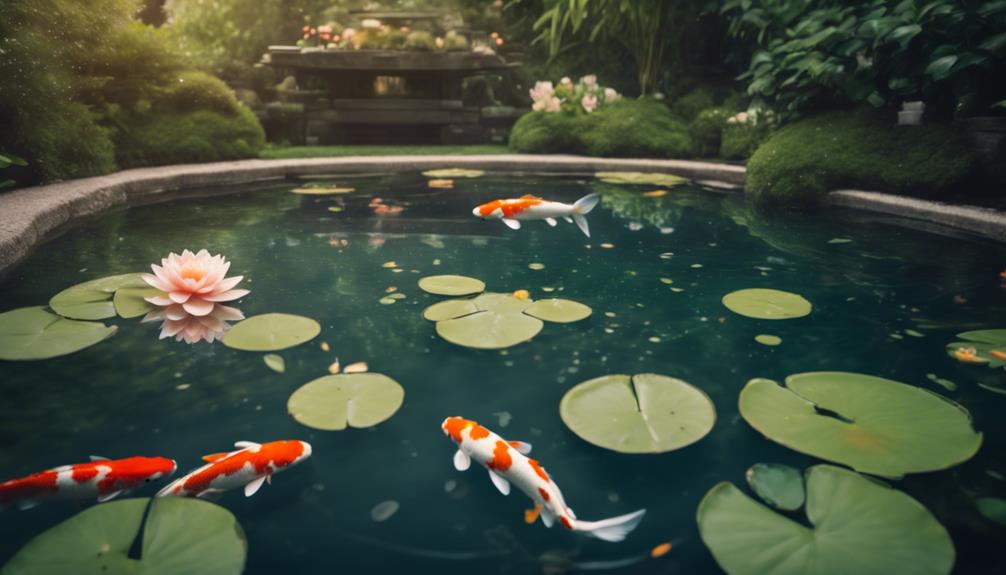
You must commit to a regular schedule of pond maintenance and care to create a thriving environment for your koi, as neglecting these tasks can have disastrous consequences. Regular water changes, monitoring of water quality, and maintenance of your filtration system are vital to guarantee the health and well-being of your koi. A well-designed filtration system, including mechanical, biological, and chemical filters, is essential for removing waste products and toxins from the pond water.
Task | Frequency | Importance |
| — | — | — |
|---|---|---|
| Regular water changes | Weekly (10% change) | High |
| Filter cleaning and replacement | Monthly | High |
| Water parameter testing | Weekly | High |
| Pond equipment inspection | Monthly | Medium |
| Aeration and circulation check | Daily | High |
Frequently Asked Questions
How Do I Encourage My Koi to Breed?
You'll encourage your koi to breed by understanding breeding triggers, such as changes in water temperature and photoperiod, and creating an ideal environment during spawning seasons, complete with regular water changes and a mature pond that fosters natural mating rituals.
Can You Over Filter a Koi Pond?
You risk over-filtering your koi pond when you prioritize excessive cleaning, causing filter overload and overkill maintenance, which leads to water polishing and filtration futility, ultimately depriving your koi of essential nutrients and beneficial bacteria.
Why Won't My Koi Breed?
"You're not getting the breeding results you want, and it's not because your koi are shy like Romeo and Juliet. It's likely due to poor Koi genetics, subpar Water quality, immature Fish age, inadequate Pond size, or unfavorable Environmental factors."
Why Won't My Pond Fish Breed?
You're wondering why your pond fish won't breed? It's likely due to poor water quality, inadequate pond size, fish stress, unfavorable environmental factors, or underlying genetic issues – all of which can hinder successful spawning.
Conclusion
As you master the art of optimizing koi pond filtration, you'll debunk the myth that koi breeding is purely luck.
Research reveals that a staggering 90% of breeding failures can be attributed to poor water quality.
By implementing the strategies outlined in this article, you'll be among the select few who consistently produce healthy, vibrant offspring.
By marrying cutting-edge filtration techniques with a deep understanding of koi biology, you'll decipher the secrets to breeding success and take your koi breeding program to the next level.

